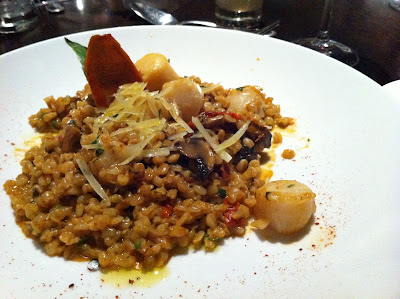Back in San Pedro de Atacama .....
As part of the tour to the local ruins in the northern desert area of Chile, we were taken to a local farm and restaurant. Our Bolivian-born guide said it was a mid-morning 'tea' of native foods. Its lovely to discover a different culture through relics, environment and food!
Known as the Atacamenos, the native of the region prefer to be known as Lickan-Antay, as the former was a tem given to them by the Spanish Colonialists. Traditional houses were round mud huts with a thatched roof. Inside, it reminded me of a Mongolian Yurt. In arid environments like the Atacama desert, its really cool to see how their architecture had to adapt to the big difference in day and nighttime temperatures. I reckon the lack of windows was mostly a insulation concern for the night. The doors, being the only view out, would strategically be built with the sacred mountain of the Lican-cabur in sight as we see below. (very faintly) This particular house is a model of what present day villages think the old house looked like. ( We are looking at pre-Inca times)




We didnt get the name of the local farm/ Restauarnt :( Its location is further out from San Pedro, so it is likely it mostly serves the locals and no tourists! There were no name boards or signs on the front either! The farm was charmingly rustic with several small vegetable plots and a small herd of llamas and goats. S2 is especially taken by the llamas, finding them friendly and most adorable out of the camelid family! (Sorry Camel...)
 |
| Check out their perky ears! Ola Llama ( pronounced sometimes as Ya-ma or Jama depending on where you take the double "l" in spanish ) |
 |
| Soy un Mocha color llama! |
The llamas are a domesticated camelids the natives came to depend on for transporting goods, as they adapted better to the high altitudes compared to the horses (introduced by the Spanish). They were also a good source of wool and meat. An old way of shearing the llama for the wool included guiding them through a specially made narrow walk-way fenced on 2 sides by cactus, so the spikes could pick up the wool as the llama ran by! The spikes are not close enough to hurt the llama.... but I guess this works for a somewhat standardised size of llamas! The wool is then spun and made into strands (see below)
 |
| Chocolate coated llama with black features! |
 |
| Llama wool. |
Hmmm... here's the highlight of our tour, finding out the traditional foods that people ate in such a harsh climate.. Though as the guide reminded us, thousands of years ago, the area though a desert, was more fertile and had a thriving oasis compared to present day. We had toasted corn kernals and quinao puffs. Their texture eaten this way is dry and not that great- reminded me of natural cereals ( non-processed!) But as a source of nutrition for the people then it must be immense!
Quinoa and I got acquainted in health food stores, where most are exported from Peru or Bolivia. I had been looking forward to having quinoa since arriving in Chile, but found that it seemed more common up north, then in Santiago, where most meals come with potatoes or rice. Sadly, we heard that this nutritious grain that has developed a demand in the health food shops of developed nations, has now become too expensive for some of the local natives, who have it as part of their natural diet :( A case of displaced nutrition when not eating locally... (for the developed nations I mean.... which would include me in the quotient, buying quinoa from the health foodstore)
 |
| Corn Kernals and Quinoa Puffs! |
Another 2 native plants crucial to the natives were the Algarobbo and Chanar Plants. They produced fruit and wood for use! The Algarobbo is a type of carob, and it can be milled into a flour or made into a syrup, as the pods which produce these has a sweet, slightly nutty flavour. We tried some bakes made from the algarobbo flour- the taste was very pleasant and mild- not overly sweet but texture was again a bit fry for me.. We washed it down with a delicious warm mint tea (that was hearty and not minty at all if you asked me !) The natives also sometimes made an alcoholic beverage from the Algarobbo, which we did not come across in the trip. Got a taste of the 2 syrups too. I was surprised! The Algarobbo syrup had a slight tang to it that reminded me of gula melaka while the Chanar one was of a molasses like consistency, and had a strange but faint association with chocolate in taste. (?) Both were quite delicious though and we thought this would be a good souvenir to bring for our kitchen! And had a hard time deciding which to get.... We wondered if the delicious stewed chestnut desert ( see previous post) was made with the algarobbo syrup since it reminded me of gula melaka!!
 |
| Bread like biscuit made from Algarobbo flour. |
 |
| Algarrobo syrup (from the pod) and Chanar syrup (from the fruit) |
This was the last we saw of these food, as back in San Pedro and Santiago, its the usual mix of tomatoes, avocados, beans, meat, potatoes and corn etc. We asked a curator at the Gustavo Le Paige Archaeological Museum in San Pedro about the present food source in the town. She remarked that close to 90% were imported from the south of Chile while the farming capacity of the region had decreased significantly as people preferred to work in the mines as that earned a better salary.



































